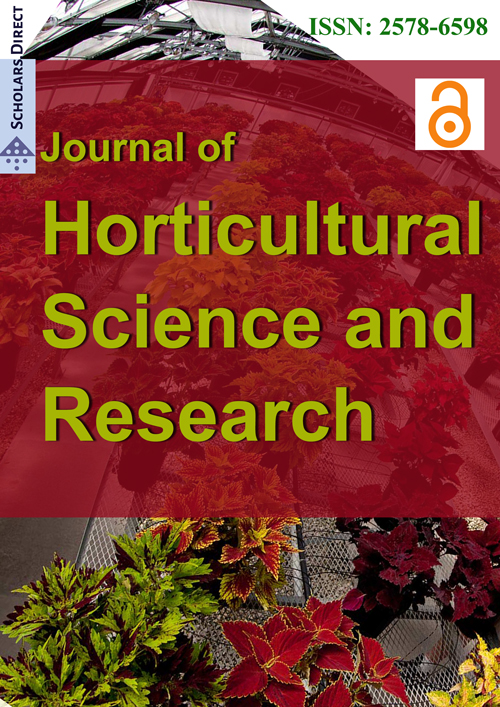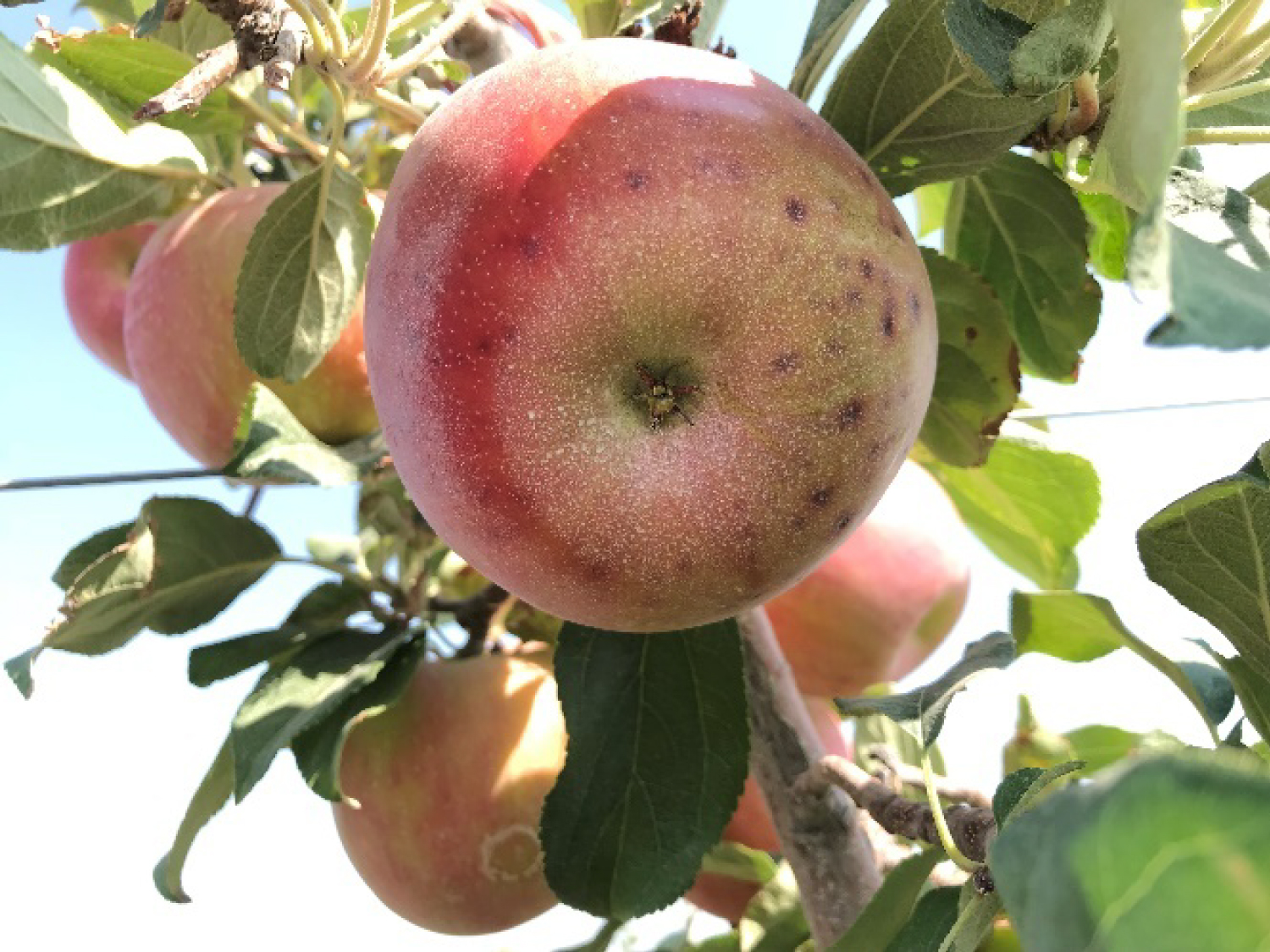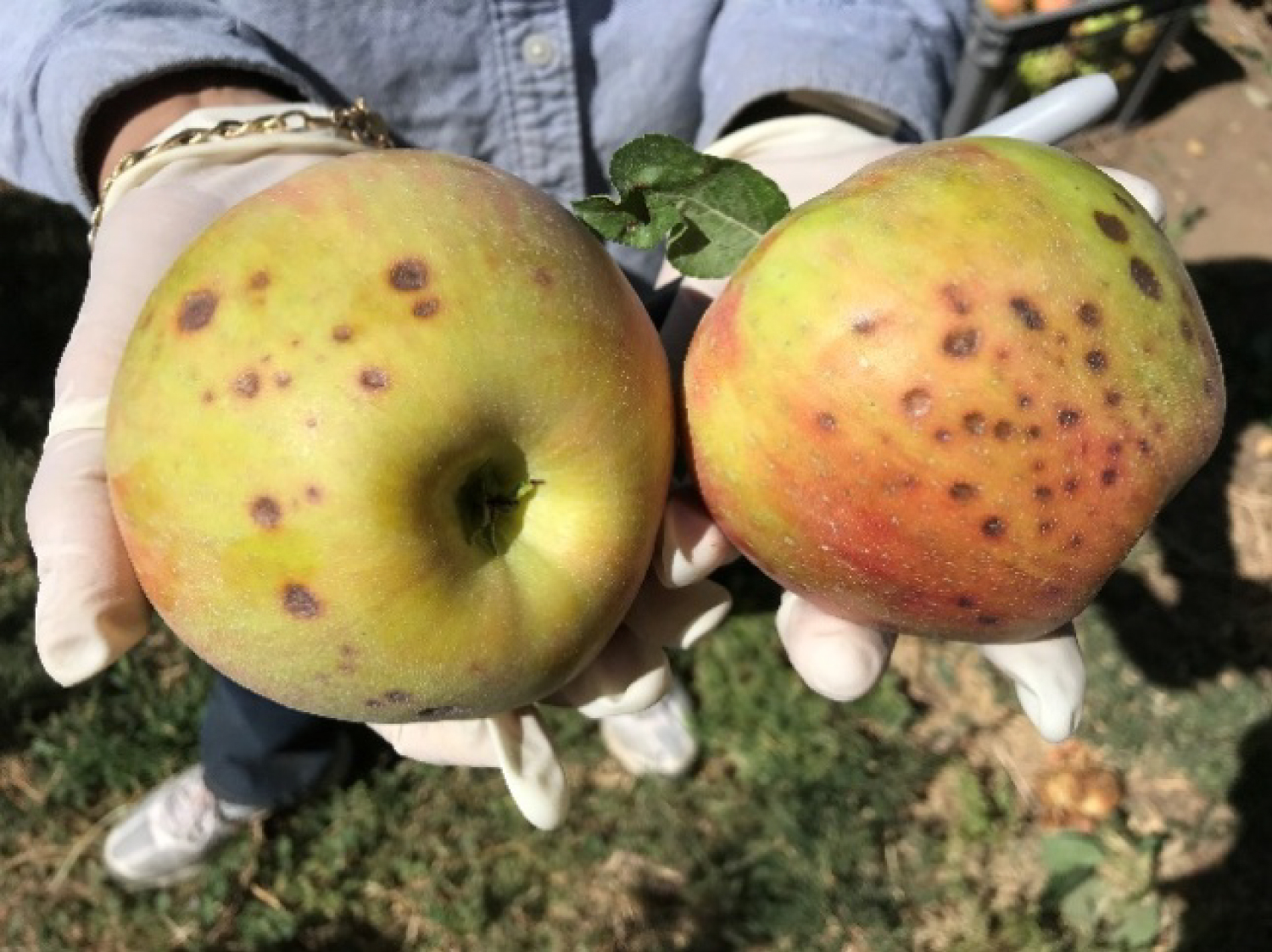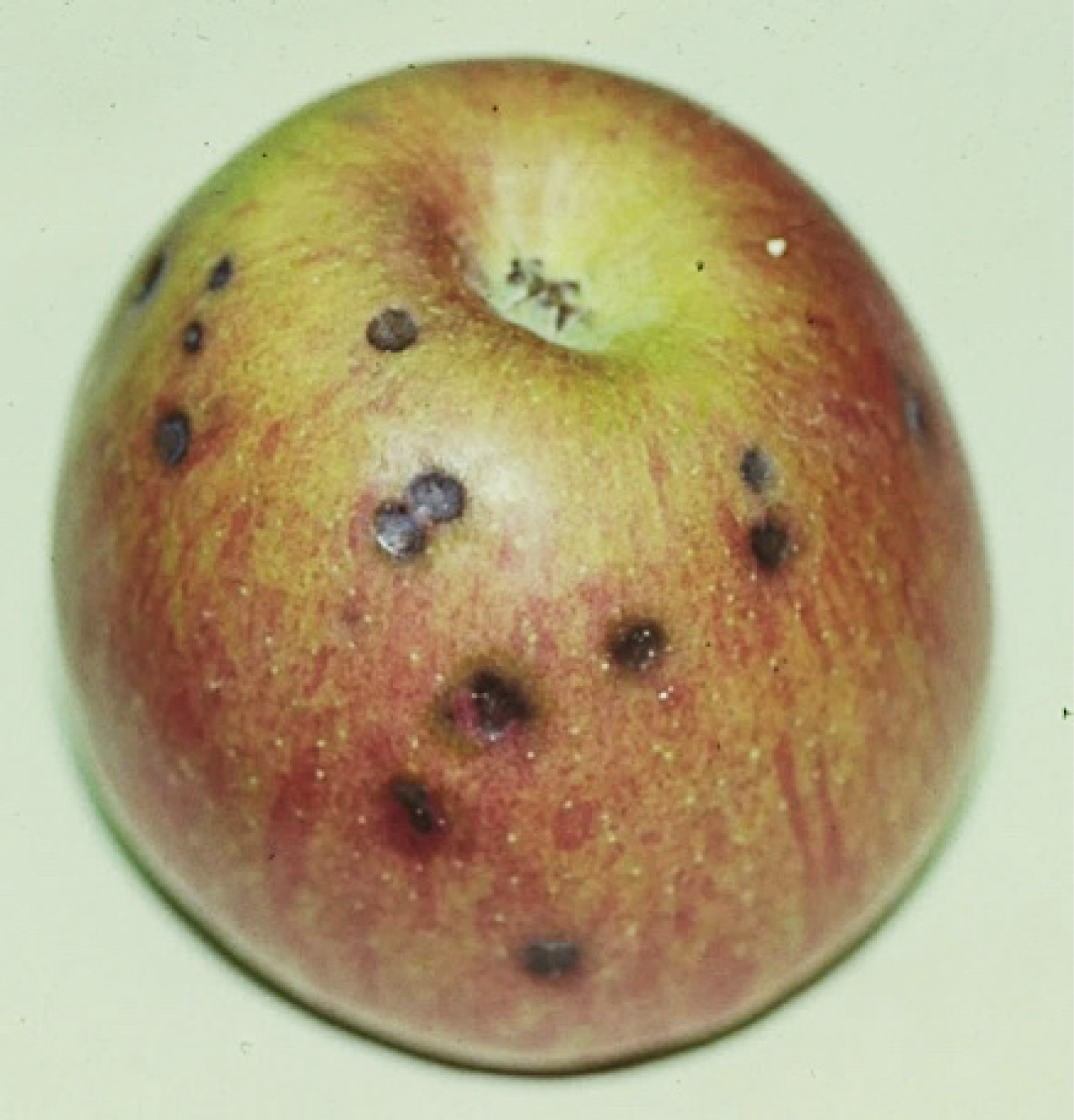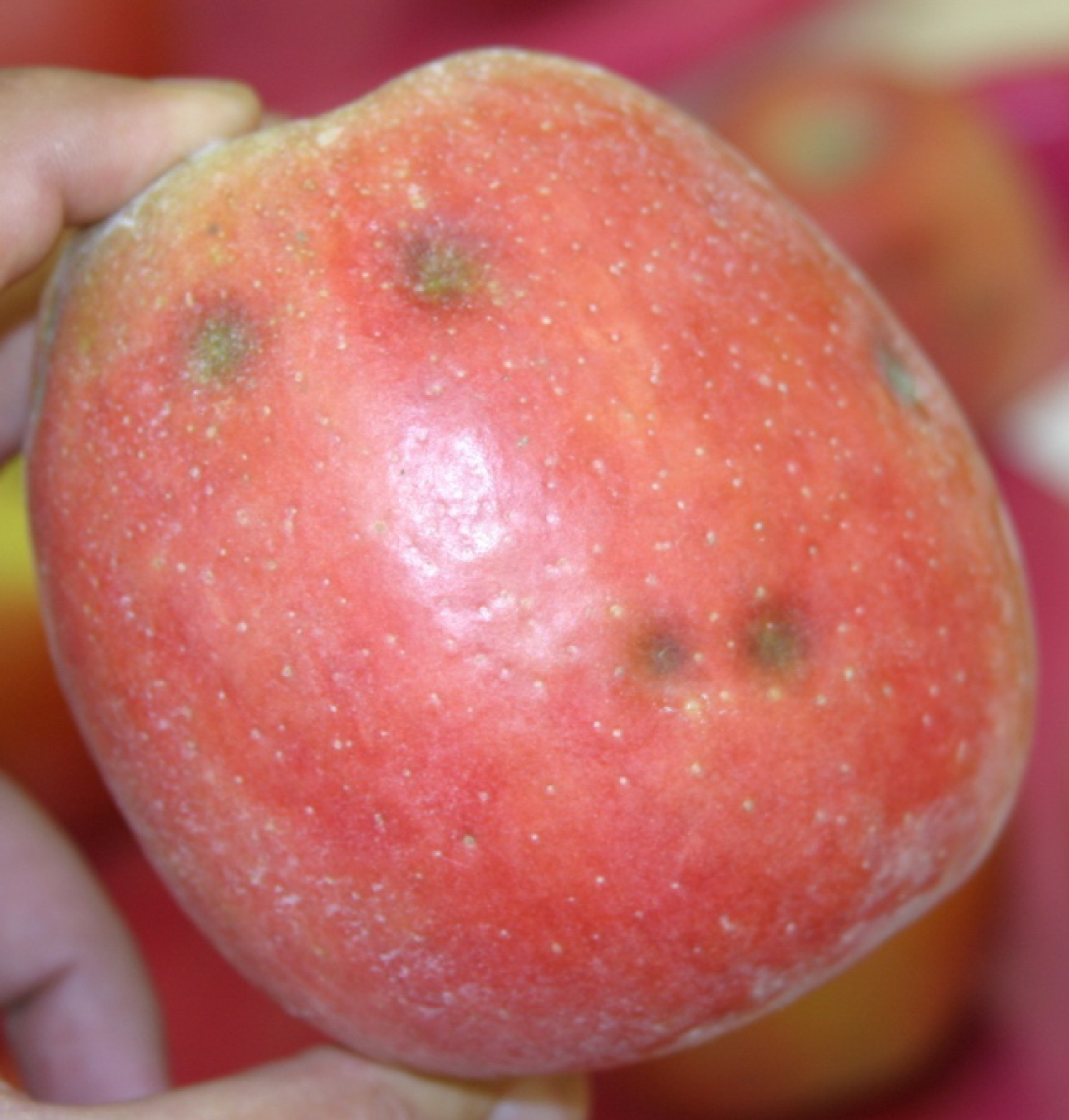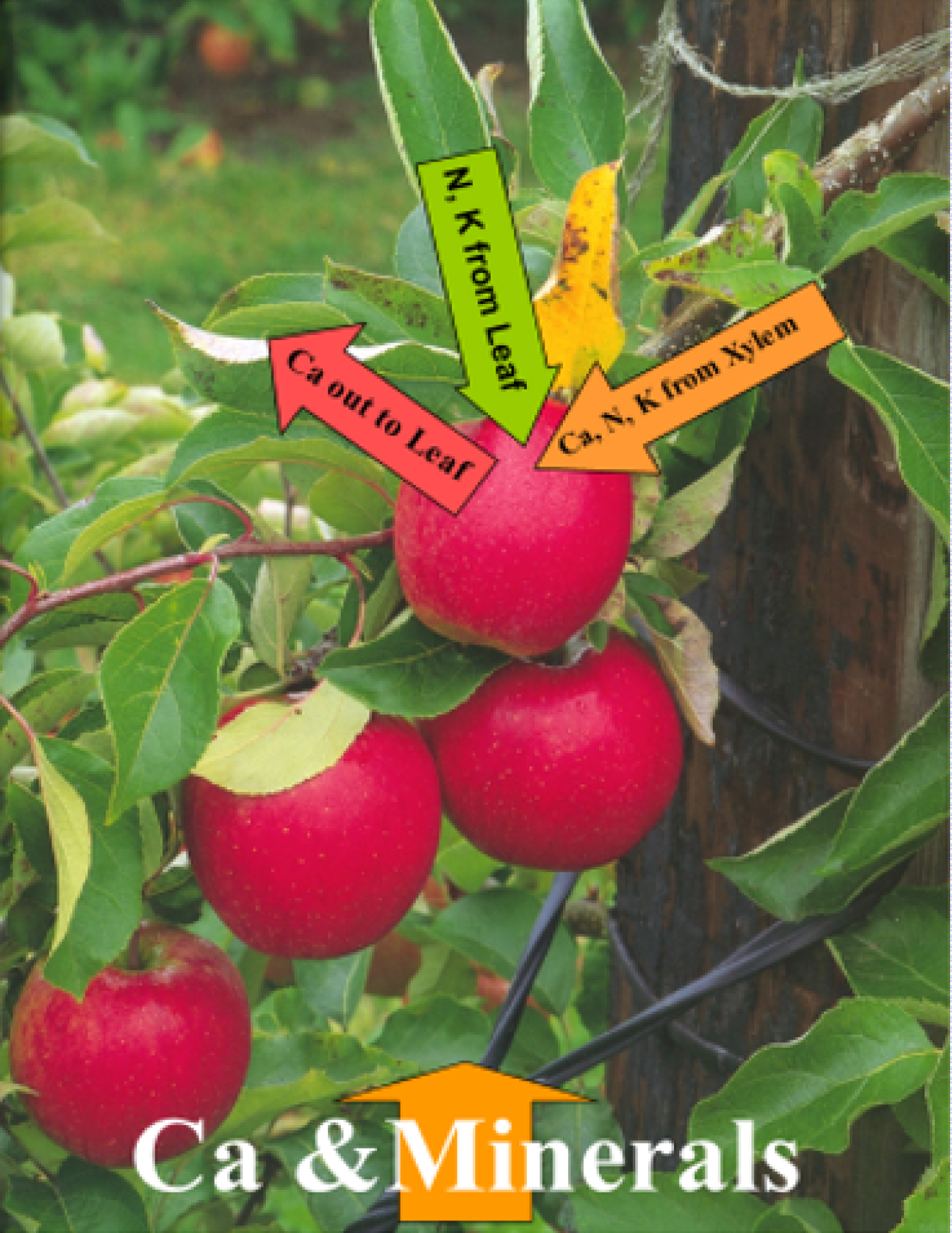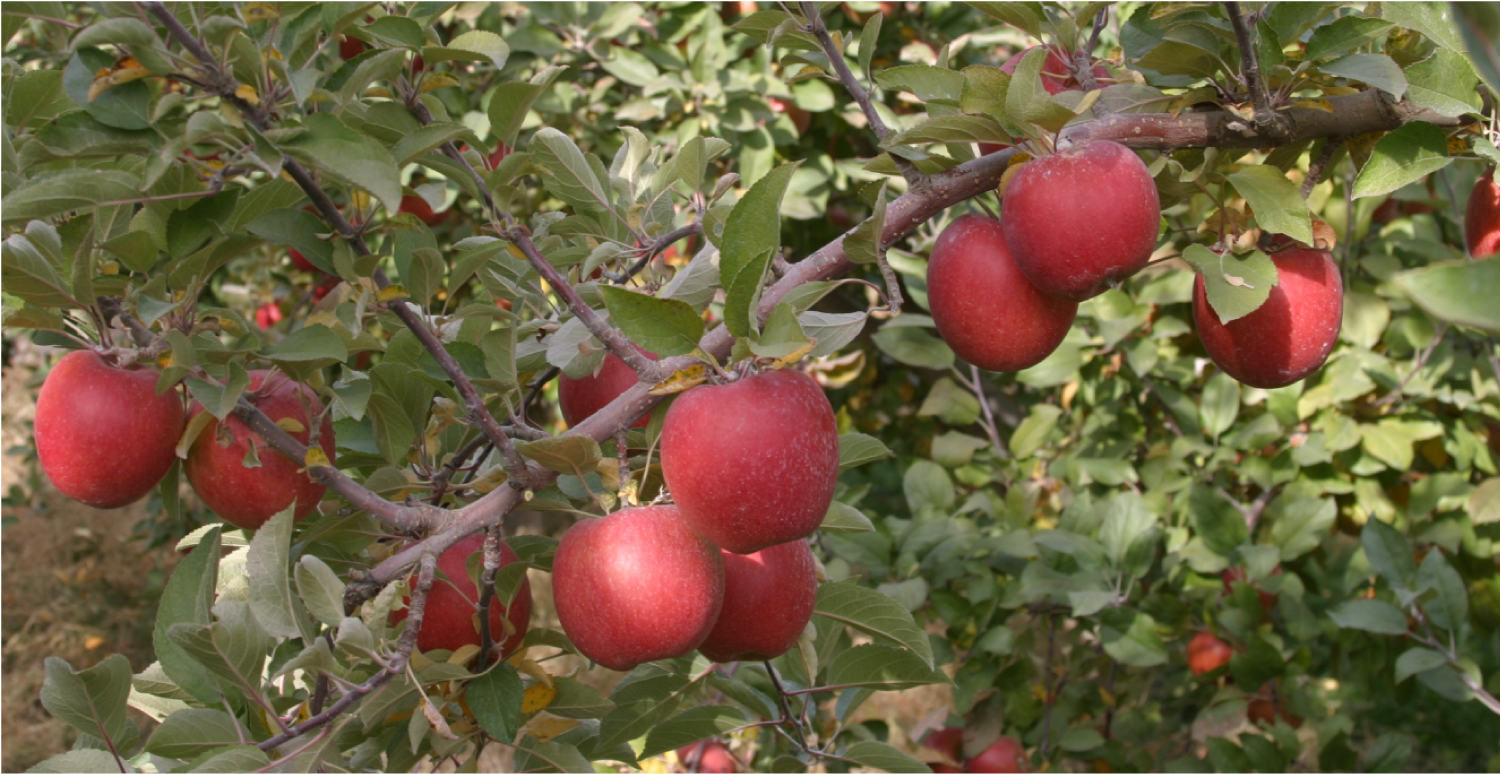Physiological and Environmental Factors Influencing Bitter Pit in Apples
Abstract
Bitter pit is a physiological disorder that occurs in pome fruit, mainly apples (Malus domestica) and pears (Pyrus communis). Although bitter pit was believed to be caused by pathogens, it is now commonly agreed that any factor that leads to low calcium (Ca) concentration or high ratios of certain mineral elements in the fruit tissue, particularly, nitrogen (N), potassium (K), and/or magnesium (Mg) to Ca can induce bitter pit disorder. Over the last three decades, several scientists, including our research team, have extensively studied the influence of numerous cultural practices and physiological and environmental factors on uptake and partitioning of these minerals and ratios, and their impacts on the severity of bitter pit disorder. Soil and ambient temperatures, soil pH level, soil physico-chemical structure and microbial activities, rootstocks, cultivar, irrigation, relative humidity, scion fruit size, and crop load are among these major factors that influence Ca balances and partitioning in the fruit tissue, and thus severity of fruit bitter pit in apples. In the past five to 10 years, our research team, in conjunction with other pomologists have been searching to better understand mineral partitioning and Ca balance under modern high density orchards with dwarf or semi-dwarf rootstocks, to reduce bitter pit and increase the net pack-out of sensitive cultivars such as 'Honeycrisp' and 'Golden Delicious' apples. In this article, we present a comprehensive overview of our research, meshed with those of other pomologists, to reveal the history and updated factors leading to the bitter pit incidence. In conclusion, an intensive coordination among physiologists from different disciplines is required to reveal the role of soil components, rootstock, tree architecture and spacing, climate and environmental factors, and genetic sensitivity to bitter pit formation in various apple cultivars.
Keywords
Calcium, Honeycrisp, Mineral imbalance, Physiological disorder, Rootstock, Susceptibility
Introduction and Symptoms
Bitter pit was first believed to be an apple disease known as "stippen" by Jaeger in Germany in 1869 [1]. Several years later, bitter pit was known as Baldwin spot [2,3], stippen [2-4], dry rot [2], brown spot [2], fruit spot [2], fruit pit [2,5], and blotchy cork [6] in Northern America. The name "bitter pit" was first used by Cobb in Australia in 1895 [7]. Bitter pit was reported to be caused by a chemical toxicity [8], viral infection [9], and persistence of starch [10]. Today, it is widely known that bitter pit is a physiological disorder that affects pome fruit, including apples (M. domestica Borkh), pears (P. communis) and quince (Cydonia oblonga), and it is caused by nutritional, cultural, and/or environmental conditions, rather than by disease-causing pathogens.
Bitter pit initially expresses symptoms internally as small dark spots in the flesh of the apple. In most cultivars it causes skin pitting which are usually first noticed as dark blotches just under the skin. Often these spots are, or become, more highly colored than the surrounding fruit surfaces, taking on a deep-red color on blush areas and remaining bright green on green or yellow surfaces [3]. As the disorder progresses, the skin darkens and becomes sunken over the spots, or pits. Pierson, et al. [3] noted that typical pits are 1.6 to 3.2 mm in diameter and are usually distributed over the calyx half of the apple. In severe cases, pits may extend up onto the shoulder of the apple. The flesh under these circular pits is darkly discolored, dry, corky or spongy, and tastes bitter, hence the name. Symptoms can manifest at any time during the growth, harvest, or post-storage stages of the apple's life [2,3,11,12], although the majority exhibit symptoms shortly after harvest (authors' personal experience).
Significance and Susceptibility
Bitter pit is a major problem to the production of high quality and marketable apples in all major apple growing areas worldwide [3]. This disorder often progresses in storage or after packing, which can lead to expensive repacking or buyer refusal at terminal destinations. Rosenberger [13] reported that as high as 50% of apple fruit can become unmarketable due to bitter pit and most varieties of apples grown in the United States are susceptible [3]. This physiological disorder mostly occurs near the calyx end of apple fruit, because this region has lower Ca concentration. Some of the most susceptible varieties include 'Honeycrisp' [3,14] (Figure 1 and Figure 2), 'Golden Delicious' [11,12,15], 'Delicious' [3,12,15], 'Granny Smith' [15], 'Winesap' [12], 'Gravenstein' [15], 'Yellow Newtown' [3,12], 'Fuji' [16] (Figure 3), 'Baldwin' [3], and 'Braeburn' (Figure 4) apple.
Factors Predisposing Apple Fruit to Bitter Pit
Mineral nutrients in the fruit
Role of Calcium: DeLong [6], Smock [17], and Garman and Mathis [18] were among the first researchers who found that bitter pit results from fruit Ca deficiency. Fruit Ca and ratios of other nutrients to Ca, are possibly the most important factors affecting bitter pit formation in apples [4,11-13,19-27]. Smock and Van Doren [28] described the first sign of bitter pit and reported that the cell walls of affected fruit collapses and plasmolysis occurs. Pit cavities are formed when the cell wall collapses. Also, Simon [29] described that fruit tissue becomes water-soaked, through influx of external water in free spaces or loss of vascular fluid due to the loss of membrane permeability as a result of Ca deficiency.
Fallahi, et al. [20] described that in addition to bitter pit, fruit Castatus affects certain diseases and firmness of apple fruit tissue, because Ca is an essential part of the structure of cell walls, and the integrity of the cell membrane. Biochemical processes and enzymatic changes in climacteric fruits such as apples result in the loss of cell wall integrity, leading to the softening and ultimately collapse of fruit tissue [20].
Cell breakdown and browning of the bitter-pitted apple fruit occur largely due to the activities of polyphenol oxidase and peroxidase enzymes [30]. Wang, et al. [31] reported that activities of catalase, peroxidase, ascorbate peroxidase and superoxide dismutase in apple fruit with bitter pit was significantly lower than those without this disorder. Lipoxygenase activity had a negative correlation with fruit Ca concentration, and thus a positive correlation with occurrence of bitter pit disorder [32-34]. De Freitas, et al. [35] suggested a connection between bitter pit and Ca2+ binding to cell walls as well as accumulation of Ca2+ in storage organelles. They later found an association between higher levels of water-soluble pectin Ca2+ and bitter pit [36].
Impacts of other minerals and their imbalanced ratios to calcium: Other nutrients associated with bitter pit disorder include nitrogen (N) [2-4,12,25,37-40], magnesium (Mg) [2-4,11,24,37,39], phosphorous (P) [4,37,39,40], potassium (K) [2-4,24,37,39], iron (Fe) [41], zinc (Zn), manganese (Mn) and copper (Cu) [42], and boron (B) [4,39,43].
Imbalances between ratios of certain minerals to Ca have more impact than merely low levels of Ca in the occurrence of bitter pit in some apple cultivars. For instance, we have frequently observed imbalances in fruit K/Ca, N/Ca, and Mg/Ca ratios in the bitter-pitted fruit of 'Honeycrisp', 'Desert Rose Fuji', 'Autumn Rose Fuji', and 'Starkspur Golden Delicious' apples. Cheng [22] also reported lower Ca and much higher K/Ca ratio in the fruit tissue of 'Honeycrisp' as compared to 'Gala' apple. The imbalances between ratios of certain minerals to Ca and their impacts on bitter pit in apples are also reported by other researchers [2,24,25,37,39,44,45]. Ben [46] reported proportion and interaction of elements such as Na/Ca, K/Ca, P/Ca and Mg/Ca has more connection with bitter pit than each element by itself. Wińska-Krysiakand Łata [33] reported that high ratio of K/Ca increases the activity of lipoxygenase enzyme in fruits, leading to higher bitter pit disorder. High fruit K and Mg are also believed to increase bitter pit incidence regardless of Ca content [47]. Fallahi, et al. [21] were able to induce severe bitter pit symptoms in 'Golden Delicious' apple fruit by vacuum infiltration of Mg, and thus increasing Mg/Ca ratio in the fruit tissue. Baugher, et al. [48] reported a strong correlation between fruit N/Ca ratio and bitter pit. They also revealed that peel nutrients had stronger correlations with bitter pit than did the flesh nutrients in 'Honeycrisp' apple. We found that fruit Ca and K/Ca ratio in the calyx end tissue had stronger association with bitter pit than did those in other portions of apple fruit tissues in 'Honeycrisp' apples.
In Figure 5 and Figure 6, we have shown schematic routes of Ca and other minerals' uptake from the soil, and their partitioning in the leaf and fruit tissues. All minerals are taken up from the soil and transferred to the top of the tree via xylem tissues, mainly through the suction force created by leaf transpiration. Under various physiological or environmental stress conditions, soil uptake of Ca via xylem tissues, may slow down while plant mobile minerals such as N and K continue moving from leaves into fruit tissues through phloem tissues. This phenomenon will lead to high N/Ca and K/Ca ratios, resulting in bitter pit disorder in apple fruit. Also, other researchers have reported that uptake, partitioning, and imbalances of mineral nutrients, and thus bitter pit, are influenced by soil and weather conditions, nutrient availability, tree age and vigor, crop load, fruit size, and rootstock [13,14,49-51].
Tree vigor
Excessive tree vigor often leads to increased incidence of bitter pit because of the higher demand that large masses of leaves have on water and nutrients [4,37,39]. One researcher [39] puts it in terms of the "leaf to fruit ratio". A high leaf to fruit ratio, as could be expected with vigorous vegetative growth, increases incidence of bitter pit because the leaves out compete the developing fruits for available Ca [39]. In general, any practice that increases competition for water and/or nutrients between leaves and fruit will increase bitter pit, especially since the leaves are stronger sinks than fruits for Ca [3,37,39]. High temperatures, particularly during the early weeks of growing season, can lead to excessive vegetative growth, which will result in excessive fruit bitter pit due to excessive consumption of Ca by the leaves. In this case, symptoms would be more severe in a year when crop load is light. In an extensive research in 1996, Fallahi and Simons [52] found that fruit Ca declines as crop load decreases in 'Delicious' apple.
Fruit and crop size
Fruit size is negatively correlated to the crop load in most apple trees. With a relatively heavy crop load, apples tend to be smaller, and with lighter crop load apples tend to be larger [2]. Larger fruit tend to develop more bitter pit and thus, any environmental and physiological factor or cultural practices that creates larger fruit, could also result in more bitter pit disorder. Therefore, fruit taken from younger trees or older trees with over-thinning and/or excessive vigor can be larger and more susceptible to bitter pit [2-4,37,53]. Relationship between mineral ratios to Ca and thinning (crop load) with apple quality attributes have been extensively studied by Cheng and Miranda [54] and Basak [55], respectively.
Soil nutrition and pH
Many of the nutrient imbalances leading to bitter pit in the fruit could be soil related. Too much soil K, Mg, or too little Ca, increases the probability of the same imbalance in the fruit [37]. Excessive N fertilization results in too vigorous vegetative growth and leads to a high leaf to fruit ratio [2,4,12,37,39]. A low soil pH can lead to aluminum and manganese toxicities and lower availability of Ca [34,37].
Pruning and shoot growth
Severe dormant pruning stimulates excessive vegetative growth [2-4]. This leads to a high leaf to fruit ratio, which is undesirable. Also, Struklec, et al. [56] reported that summer pruning of apple trees in July resulted in better fruit color, more Ca concentration, and reduced bitter pit, internal flesh browning and weight loss during storage of fruits held at 4 ℃.
Water relations
Water stress in both tree and fruit was one of the earliest factors recognized to promote bitter pit [2,3]. Both excessively low and high humidity in the storage or water in the orchard can enhance the likelihood of bitter pit [2]. Water deficit stress can lower fruit Ca [4], while high rates of irrigation can result in increased vegetative growth and larger fruits [39,57]. Application of irrigation water at 50% of evapotranspiration (ETc) reduced fruit size and increased firmness but did not have a major impact on bitter pit in 'Autumn Rose Fuji' apples [57].
Also, system of water delivery impacts mineral uptake and quality of apples. Fallahi, et al. [57] found that using a micro-jet sprinkler system to deliver 50% of ETc required more water than using a drip system to deliver 65% ETc, while fruit from trees in the latter treatment had much better-quality attributes at harvest and after storage.
Harvest maturity
In general, larger apple fruit tend to show more bitter pit. Nevertheless, stage of fruit maturity at harvest can influence bitter pit severity. While terms such as "immature", "mature and ripe" are somewhat ambiguous, it has been noted that earlier harvested apples tended to develop more bitter pit than do later harvested apples [2,3,37]. Studying seasonal mineral fluctuation of 'Stark Spur Golden Delicious' apple, Fallahi, et al. [5] found that that the final status of apple fruit Ca is already finalized a few weeks before harvest, even before color is fully developed.
"Total content of a mineral element" in the fruit should be clearly differentiated from its "concentration" when interpreting any bitter pit incidence. For instance, two apple fruits from the same tree may have different sizes but similar total Ca content at harvest time. In that case, the larger fruit is more likely to have a higher percentage dry weight, leading to dilution of fruit Ca and thus resulting in higher bitter pit.
Rootstocks
It is known that rootstocks affect physiological disorders [2,39], yet there is little documentation in this field. Faust and Shear [58] postulate based on an Australian study, that a rootstock producing vigorous growth, such as seedlings, will cause more bitter pit than a less vigorous dwarfing rootstocks. Drake, et al. [59] suggested that 'Goldspur' apple fruit from dwarfing M.26 rootstock to be higher in total Ca than moderately dwarfing M.111 or non-dwarfing seedling rootstocks. Nevertheless, Fallahi, et al. [19] reported that 'Starkspur Golden Delicious' on M.26 had lower percentage of fruit Ca and higher bitter pit than those on other rootstocks. In their report, fruit Ca showed negative correlations with bitter pit, storage rot and field internal ethylene, but positive correlation with firmness [19]. Later, in a somewhat similar study, Tatarinov [60] also observed that apple trees grafted on M26 rootstock had lower fruit Ca and higher acidity and as a result more bitter pit. Skrzyński [61] found more bitter pit and flesh browning in apples grafted on M9 rootstock. 'Fuji' apple fruits had more bitter pit when trees were directly grafted on M26 as compared to when it was grafted into 'Granny Smith' interstem with M.26 rootstock [62]. Apple fruit on M.7 rootstock had higher skin Ca and smaller fruit size, and thus lower bitter pit than those on M.26 rootstock [63]. Kim and Ko [64] concluded that incidence of apple bitter pit is more severe in vigorous rootstocks compared to less vigorous rootstocks which is consistent with our long-term observation in 'Honeycrisp' apples.
Heat stress
High temperatures can lead to increased incidence of bitter pit. Heat stress, especially early in the season, influences Ca availability to the fruit [39]. This is critical because in the six weeks after full bloom an apple fruit accumulates approximately 90% of its total Ca [4,5,27,65]. Also, Ferguson, et al. [66] described the impacts of air temperature and fruit position on the tree canopy among other important pre-harvest factors that caused bitter pit disorder. The factors contributing to bitter pit in apple are inextricably linked together in the ecosystem immediately surrounding the tree.
Prediction of Bitter Pit
Predicting bitter pit is difficult under the best of circumstances. Attempts to correlate leaf, fruit peel, and fruit flesh Ca concentrations to occurrence of bitter pit has had limited success, mostly due to year-to-year variations [45,51]. Prediction of bitter pit would assist producers in the sales strategy of their apples. Symptoms of fruit bitter pit in sensitive apple cultivars are more visible after harvest and storage than in the orchard or at harvest. Prediction of bitter pit and some other quality attributes, using preharvest mineral nutrient and certain other preharvest factors were intensively studied in early-to-late 1980's. Fallahi, et al. [51] reported that preharvest mineral nutrients would provide a strong tool for prediction of quality attributes of 'Starkspur Golden Delicious' apple within the same year. However, the use of this annual model would not be a strong predictor for the next year's quality factors. In that report, fruit size and N concentration had positive, while fruit Ca had negative correlations with bitter pit. Crop load and variations among the environmental factors between years were the main reasons for the poor estimation of fruit quality when using preharvest mineral nutrients of one year to predict the quality attributes of the previous or the following year. To alleviate this problem, Fallahi, et al. [67] developed an extensive "ranking" model where fruit quality attribute of each year could be predicted regardless of crop load or the environmental factors. In the ranking model, mineral nutrients, particularly fruit Ca, N, K, and Mg are ranked based on the percentile of their concentrations in a given region a few weeks before harvest in each season. In the ranking model, apple fruits with low N percentile (ranking) had better color and higher soluble solids, but those with more Ca percentile had lower bitter pit incidence [67].
Based on Fallahi, et al. [19,52], extremely heavy cropload may result in unmarketable small size with higher Ca concentrations, leading to less bitter pit. Therefore, apple fruit should be thinned during bloom or post-bloom to an optimum level to produce a regular annual bearing of fruit with optimum size and lower or no bitter pit. Blossom thinning to induce regular cropping has been extensively studied by Fallahi, et al. [68]. At this time, we are seaching to find an optimum time and level of fruit thinning to minimize bitter pit in 'Honeycrisp' apple which is a sensitive cultivar.
A rather quick fruit evaluation near the harvest would assist growers and packinghouse managers to make a better decision about their crop based on their potential for bitter pit development. To achieve this goal, Fallahi, et al. [21] elevated the fruit Mg concentrations of 'Golden Delicious' apple by vacuum infiltration of Mg solution and induced bitter pit-like symptoms within a short time. This technique seems to be a reliable technique for predicting bitter pit occurrence after harvest. Another reliable technique for a quick prediction of bitter pit was reported by Tukey and Kupferman [69]. In that technique, apple blocks suspected of bitter pit will be identified. Large apple fruit from the upright limbs of these blocks will be sampled two weeks before the expected harvest time. These fruit samples will be dipped in a 2000 ppm solution of ethephon (a ripening agent) and maintain at room temperature for two weeks. This amount would equate to 1.5 teaspoon ethephon in 3.785 liters of water. If no symptoms develop by harvest, bitter pit is unlikely in that particular area [69]. In this test, if bitter pit develops, harvest should be postponed as long as possible.
Control
Preharvest control
General orchard management: Good management and record keeping are good approaches to minimizing losses from this disorder. Identification of cultivars and areas in the orchard that have a history of bitter pit are among the most important components of management. Keeping a detailed record of environmental conditions, cultural practices, applications of fertilizers and other spray materials, and anything that might affect the trees and fruit would help formulate an effective control strategy.
Soil nutrition: Nutrients and tree vigor are main components in the development of bitter pit. If possible, do not use N fertilizers [54,69], as they stimulate vigor; otherwise, use low to moderate rates. Minimum applications of N fertilizers are being developed and recommended for modern high-density orchards of new apple cultivars under different climates. In modern high-density apple orchards, N fertilizers are often applied with water (fertigation) and N management has become more efficient and less wasteful, and thus safer to the environment.
The demand for K in high-density orchards to fulfil the needs of heavy crop is high, and even soils with sufficient K can be depleted to a deficiency level if orchard K is not resupplied frequently [70]. However, excessive K application must be avoided [69] as it can stimulates bitter pit, particularly in sensitive cultivars such as 'Honeycrisp'. Micronutrients, especially zinc, iron and boron, can be applied as needed. For heavy acid soils, application of 4 t/ha of gypsum annually to the soil surface makes Ca more available [71].
Irrigation practices: Irrigation was one of the first factors recognized as being associated with bitter pit. To minimize bitter pit, a steady, well-regulated supply of water should be maintained throughout the growing season [3,54,57], although one source recommends delaying irrigation until 3-4 weeks post-bloom to encourage warmer soil, better root growth and Ca uptake [69]. Very low soil moisture decreases the concentration of Ca within the fruit [72] and promotes small apples [25]. Excess soil moisture can lead to prolonged shoot growth, larger fruit, and higher N/Ca and K/Ca ratios [25], all of which promote bitter pit. In very hot weather (over 29 degrees C.), significant temperature reductions have been achieved with over-or under-tree sprinklers and has led to reduced incidence of bitter pit [69].
Pruning: Avoid dormant pruning too heavily, as it stimulates excess vegetative shoot [4,37,39,54,69]. This leads to a high leaf-to-fruit ratio in which the leaves out-compete the fruit for available water and nutrients. Summer pruning can reduce bitter pit in some apples and reduces cork spot (a calcium deficiency disorder in pears) by lowering the leaf to fruit ratio [25].
Thinning and fruit set: It is important to manage the final crop load by thinning to minimize potential bitter pit and establish regular cropping every year [54,69]. Early thinning increases return bloom [54]. Over-thinning fruit should be avoided [54,69], as this practice leads to an unusually high leaf to fruit ratio, and thus large fruit size, which is more succetable to bitter pit. Adequate pollinizers and pollinators should be furnished to enhance the number of viable seeds [54,69], as seeds exert a major influence in attracting Ca to the developing fruitlet.
Foliar Ca sprays: Apple bitter pit can be drastically reduced by preharvest foliar Ca sprays [5,13,18] and postharvest infiltration [21]. We believe that best time for spraying Ca is before fruit tissue becomes excessively high in K/Ca ratio which leads to bitter pit. Contrary to the case in fruit tissues, leaf Ca status does not have any known or simple relations with bitter pit [51], and thus, and Ca spray droplets that land directly on fruit tissue would be effective in reduction of bitter pit. In our opinions, leaf Ca can be only one of the multifaceted growth and developmental factors that would be used in a bitter pit prediction model and that needs further studies.
Several Ca-containing products are currently used for foliar application and include calcium chloride, calcium nitrate, calcium sulfate, and amino acid-calcium chelates [25,73]. Calcium chloride and calcium nitrate appear more effective than calcium sulfate [25,73]. Calcium chloride is most commonly used [73], as it is less injurious to fruit and foliage, if applied at moderate temperatures [73], does not delay maturity or red color development [15], and is least expensive. There are several amino-acid-based and organic acid-calcium chelates in the market, but their efficacy and toxicity should be further studied [73]. After selecting a material, rate and directions of application should be carefully followed. Three to five applications, starting no more than five weeks after petal fall, are necessary [15,73,74], as both early and late sprays are important [21]. The last spray should be applied no less than two weeks, and not more than four weeks, before harvest [15]. To reduce spray injury, reduced/diluted rates with at least 935 L of spray per hectare should be used [73]. Spraying of several chemicals is not recommended when temperatures are above 29 ℃ [15,73] or under slow drying conditions [73]. In an extensive research over two seasons, we found that timely sprays of Sysstem®-Cal, (a calcium-containing compound manufactured and distributed by Agro-K Science Driven Nutrient, Minneapolis, MN) drastically reduced bitter pit incidence, even in 'Braeburn' apple which is a susceptible cultivar (Figure 7).
Harvest maturity and postharvest control
Maturity: Earlier harvested apples tend to develop more bitter pit than those harvested later [2,3,37]. Growers must wait for optimum maturity before picking. A preharvest test with ethephon to determine potential for bitter pit incidence, as described earlier, would be beneficial for sensitive apple cultivars.
Postharvest cooling: Fruit suspected of bitter pit should be rapidly cooled to 0 ℃, as warmer temperatures aggravate bitter pit conditions [69].
Storage: Suspected fruit should be segregated and held for two to four weeks before packing [69]. This is sufficient time for pits to develop, allowing affected fruit to be sorted out before the packing operation. A high relative humidity in storage should be maintained [15]. Precooling and rapid transfer of fruit to the controlled atmosphere conditions decrease incidence of bitter pit [75].
Drenches and infusion treatments: While common in other areas of the world, postharvest calcium drenches and pressure infusion treatments are not practiced widely in the United States.
Conclusion
Bitter pit is, and will continue to be, a serious disorder affecting apple quality. However, this disorder can be minimized. Basic to this effort is understanding the various factors involved and modifying orchard practices and intervening physiological factors accordingly. Careful attention should be given to mineral nutrient supplies, partitioning, and their ratios to Ca, especially in the bitter pit-sensitive apple cultivars. Further investigation is warranted in crop load management, time and levels of thinning and time of harvest in sensitive commercial apple cultivars.
Acknowledgements
We thank the Idaho Apple Commission and the Idaho Agricultural Experiment Station for their financial support of this project. This work was supported in part by U.S. Department of Agriculture National Institute of Food and Agriculture Specialty Crop Research Initiative project "Apple Root 2 Fruit: Accelerating the development, evaluation and adoption of new apple rootstocks" (2016-51181-25406). We are also thankful to all scientists and technicians in the University of Idaho Pomology and Viticulture Program who assisted us in different aspects of bitter pit-related research projects.
References
- Jaeger G (1869) Uber das Pelizoder Stippinwerden Kernobst frucht. Illus. Monash obst u-Weinbau 16: 318-319.
- Faust M, Shear CB (1968) Corking disorders of apples: A physiological and biochemical review. Botanical Review 34: 441-469.
- Pierson CF, Ceponis MJ, McColloch LP (1971) Market diseases of apples, pears, and quinces. USDA-ARS, Agric. Handbook, 376: 7-10.
- Shear CB (1975) Calcium-related disorders of fruits and vegetables. Hort Science 10: 361-365.
- Fallahi E, Westwood MH, Richardson DG, et al. (1984) Effects of rootstocks and K and N fertilizers on seasonal apple fruit mineral composition in a high-density orchard. Journal of Plant Nutrition 7: 1179-1201.
- DeLong WA (1936) Variations in the chief ash constituents of apples affected with blotchy cork. Plant Physiol 11: 453-456.
- Cobb NA (1895) Diseases of plants and their remedies. 11. Bitter Pit of apples. Agric. Gaz. N.S.W 6: 859-861.
- Smith AJM (1926) Bitter pit in apples: A review of the problem. Food Inv. Board (Great Britain) Spec. Rept. 28: 23.
- Atanasoff D (1934) Is bitter pit of apples a virus? Phytopath Z 13: 1-8.
- Carne WM, Pittman, HA, Elliot HG (1929) Bitter pit of apple in Australia. Bul CSIRO (Austral.) 4: 1-23.
- Hopfinger JA (1978) Physiological role of calcium and magnesium in the development of bitter pit in 'Golden Delicious' apples. Washington State University, Pullman, Washington.
- Horn AS (1975) Bitter pit of apples. University of Idaho, Cooperative Extension Service, CIS, 281.
- Rosenberger DA, Schupp JR, Watkins CB, et al. (2004) Controlling bitter pit in 'Honeycrisp' apples. HortTechnology 14: 342-349.
- Donahue DJ, Reig G, Wallis AE, et al. (2018) Bitter pit mitigation and the 'Honeycrisp' apple: Prohexadione-calcium and bourse pinching effects on bitter pit, shoot extension, and fruit Size. Fruit Quarterly 26: 23-28.
- Baxter P, Higgins K, Soderlund R (1979) Bitter pit of apples. Dept of Agriculture, Govt of Victoria, Australia, 215: 79.
- Miqueloto A, Amarante CVT, Steffens CA, et al. (2011) Physiological, physicochemical and mineral attributes associated with the occurrence of bitter pit in apples. Pesq Agropec Bras 46: 689-696.
- Smock RM (1941) Studies on bitter pit of apples. Cornell Univ Agri Expt Sta Memoir, 234.
- Garman P, Mathis WT (1956) Studies of mineral balance as related to occurrence of 'Baldwin' spot in Connecticut. Conn Agr Expt Sta Bul 601: 5-19.
- Fallahi E, Richardson DG, Westwood MN, et al. (1985) Relationship among mineral nutrition, ethylene and post-harvest physiology in apples on six rootstocks. Scientia Horticulturae 25: 163-175.
- Fallah E, Conway WC, Hickey KD, et al. (1997) The role of calcium and nitrogen in postharvest quality and disease resistance of apples. Hort Science 32: 831-835.
- Fallahi E, Righetti TL, Wernz JG (1987) Effects of dip and vacuum infiltration of various inorganic chemicals on postharvest quality of apple. Communications in Soil Science and Plant Analysis 18: 1018-1029.
- Cheng L (2017) Challenges and opportunities for 'Honeycrisp' nutrient management. Proc Empire State Expo.
- Kalcsits LG, Heijden VD, Reid M, et al. (2017) Calcium absorption during fruit development in 'Honeycrisp' apple measured Using 44Ca as a stable isotope tracer. Hort Science 52: 1804-1809.
- Perring MA (1968) Mineral composition of apples. VIII.†-Further investigations into the relationship between composition and disorders of the fruit. J Sci Fd Agric 19: 640-645.
- Raese JT (1988) Calcium: Effects on apple and pear disorders and fruit quality. Wash St Hort Assn Proc, 84th Ann Mtg, 247-257.
- Crassweller RM, Marini RP, Baugher TA, et al. (2019) Five-year nutritional study of apples in commercial high-density orchards. International Society for Horticultural Science.
- Wilkinson BG (1968) Mineral composition of apples IX.† -Uptake of calcium by the fruit. J Sci Fd Agric 19: 646-647.
- Smock RM, Van Doren A (1937) The history of bitter pit in apples. Proc Am Soc Hort Sci 35: 176-179.
- Simon EW (1978) The symptoms of calcium deficiency in plants. New Phytol 80: 1-15.
- Napier D, Combrink N (2006) Aspects of calcium nutrition to limit plant physiological disorders. V International Pineapple Symposium 702: 107-116.
- Wang L, Jiang W, He Z, et al. (2001) Studies on the relationship of the development of bitter pit in apple fruits with the contents of calcium and magnesium and the activities of antioxidant enzymes. Acta Hort 28: 200-205.
- Sharma R, Pal R, Singh D, et al. (2012) Relationships between storage disorders and fruit calcium contents, lipoxygenase activity, and rates of ethylene evolution and respiration in 'Royal Delicious' apple (Malus x domestica Borkh.). The Journal of Horticultural Science and Biotechnology 87: 367-373.
- Winska-Krysiak M, Lata B (2010) Influence of lipoxygenase activity and calcium and potassium contents on bitter pit occurrence in commercial apple cultivars. Folia Horticulturae 22: 13-17.
- Jemric T, Fruk I, Fruk M, et al. (2016) Bitter pit in apples: Pre- and postharvest factors: A review. Spanish Journal of Agricultural Research 14: 1-12.
- De Freitas ST, do Amarante CVT, Labavitch JM, et al. (2010) Cellular approach to understand bitter pit development in apple fruit. Postharvest Biology and Technology 57: 6-13.
- De Freitas ST, do Amarante CVT, Mitcham EJ (2015) Mechanisms regulating apple cultivar susceptibility to bitter pit. Scientia Horticulturae 186: 54-60.
- Mielke EA, Facteau TJ (1988) An overview of calcium and it's interactions in fruit trees. Wash St Hort Assn Proc, 84th Ann Mtg, 236-246.
- Raese JT (1989) Calcium's effect on bitter pit and fruit quality in 'Red Delicious' and 'Golden Delicious' apples. Good Fruit Grower 1: 37-41.
- Raese JT (1989) Important considerations about calcium on apples and pears. Good Fruit Grower 1: 32-35.
- Recasens I, Benavides A, Puy J, et al. (2004) Pre-harvest calcium treatments in relation to the respiration rate and ethylene production of 'Golden Smoothee' apples. J Sci Food Agric 84: 765-771.
- Robinson T, Lopez S (2012) Crop load affects 'Honeycrisp' fruit quality more than nitrogen, potassium, or irrigation. Acta Hortic 940: 529-537.
- Sanz M, Machín J (1999) Applying floral analysis for the prognosis and diagnosis of bitter pit. ITEA-Inf Tecn Econ Agr Prod Veg 95: 118-124.
- Liu H, Han Z (1997) Apple fruit mineral nutrition. J Fruit Sci 14: 73-78.
- Wójcik P, Mika A (1996) Effect of fertilization of apple trees with boron on the growth, yield and fruit quality. Zeszyty Problemowe Postepow Nauk Rolniczych 434: 419-424.
- Drake M, Bramlage WJ, Baker JH (1974) Correlations of calcium content of 'Baldwin' apples with leaf calcium, tree yield, and occurrences of physiological disorders and decay. Journal of the American Society for Horticultural Science 99: 379-380.
- Ben J (1998) Estimation of apple storage quality based on fruit analysis. Int Sem: Ecological Aspects of Nutrition and Alternatives for Herbicides in Horticulture, Warszawa, Poland, 7-8.
- Krishkov E (2007) Factors influencing the incidence of bitter pit on apple fruits and control measures. Proc Agric Sci XL, 22-26.
- Baugher TA, Marini R, Schupp JR, et al. (2017) Prediction of bitter Pit in 'Honeycrisp' apples and best management implications. HortScience 52: 1368-1374.
- Ferguson IB, Watkins CB (1992) Crop load affects mineral concentrations and incidence of bitter pit in 'Cox's Orange Pippin' apple fruit. Journal of the American Society for Horticultural Science 117: 373-376.
- Baugher TA, Marini R, Schupp JR (2020) Crop load, better nutrient management curb bitter pit. Fruit Growers News.
- Fallahi E, Righetti TL, Richardson DG (1985) Predictions of quality by preharvest fruit and leaf mineral analyses in 'Starkspur Golden Delicious' apple. Journal of the American Society for Horticultural Science 110: 524-527.
- Fallahi E, Simons B (1993) Effects of rootstock and thinning on yield, fruit quality and elemental composition of 'Redspur Delicious' apple. Communications in Soil Science Plant Analysis 24: 589-601.
- Telias A, Hoover E, Rosen C, et al. (2006) The effect of calcium sprays and fruit thinning on bitter pit incidence and calcium content in 'Honeycrisp' apple. Journal of Plant Nutrition 29: 1941-1957.
- Cheng L, Miranda M (2018) Why is 'Honeycrisp' so susceptible to bitter pit? New York State Horticultural Soc 26: 1.
- Basak A (1999) The storage quality of apples after fruitlets thinning. Acta Horticulturae 485: 47-53.
- Struklec A (1994) Can summer pruning increase the calcium concentration of apples and reduce the occurrence of physiological disorders? Erwerbsobstbau 36: 158-160.
- Fallahi E, Neilsen D, Neilsen GH, et al. (2010) Efficient irrigation for optimum fruit quality and yield in apples. HortScience 45: 1616-1619.
- Faust M, Shear CB (1972) The effect of calcium on respiration of apples. Journal of the American Society for Horticultural Science 97: 437-439.
- Drake SR, Larsen FE, Fellman JK, et al. (1988) Maturity, storage quality, carbohydrate, and mineral content of 'Goldspur' apples as influenced by rootstock. Journal of the American Society for Horticultural Science 113: 949-952.
- Tatarinov AN (1992) Dwarfing clonal apple rootstock M.26. Sadovodstvoi Vinogradarstvo 12: 9-10.
- Skrzynski J (2007) The effect of rootstocks on the retention of apple quality. ISHS Acta Horticulturae 732: 155-158.
- Drake SR, Williams MW, Raese JT (1997) Interstem and its relationship to 'Fuji' apple quality. Journal of Tree Fruit Production 2: 99-106.
- Raese JT, Drake SR (2000) Effect of calcium spray materials, rate, time of spray application, and rootstocks on fruit quality of 'red' and 'golden delicious' apples. Journal of Plant Nutrition 23: 1435-1447.
- Kim MS, Ko KC (2004) Effects of forms and levels of nitrogen and levels of calcium on bitter pit incidence in 'Fuji' apples (Malus domestica Borkh.). Korean Journal of Horticultural Science and Technology 22: 200-205.
- Quinlan JD (1969) Chemical composition of developing and shed fruits of Laxton's Fortune apple. Journal of Horticultural Science 44: 97-106.
- Ferguson I, Volz R, Woolf A (1999) Preharvest factors affecting physiological disorders of fruit. Postharvest Biology and Technology 15: 255-262.
- Fallahi E, Righetti TL, Raese TJ (1988) Ranking tissue mineral analysis to identify mineral limitation on quality in apple. J Americ Soc for Hortic Sci 113: 382-389.
- Fallahi E, Willemsen KM (2002) Blossom thinning of pome and stone fruit. HortScience 37: 474-475.
- Tukey RB, Kupferman E (1983) Bitter pit of apple and its control. Washington State University, Cooperative Extension.
- Fallahi E, Arzani K, Fallahi B (2013) Long-term leaf mineral nutrition in 'Pacific Gala' apple Malus × domestica Borkh.) as affected by rootstock, type and irrigation system during six stages of tree development. The Journal of Horticultural Science and Biotechnology 88: 685-692.
- Wilms FWW, Basso C (1988) Soil amelioration for apple production in southern Brazil. ISHS Acta Hort 232: 193-203.
- Goode JE, Ingram J (1971) The effect of irrigation on the growth, cropping, and nutrition of Cox's Orange Pippin' apple trees. Journal of Horticultural Science 46: 195-208.
- (1990) Spray guide for tree fruits in Eastern Washington. Washington State University.
- Stahly EA (1986) Time of application of calcium sprays to increase fruit calcium and reduce fruit pitting of apples sprayed with TIBA. HortScience 21: 95-96.
- Prinja J (1989) The effects of high CO2 pre-storage treatments and rate of establishment of controlled atmosphere conditions on bitter pit and bruise susceptibility of 'Bramley's Seedling' apples. Journal of Horticultural Science 64: 533-539.
Corresponding Author
Esmaeil Fallahi, Department of Plant Sciences, University of Idaho, Parma Research and Extension Center, 29603 U of I Lane, Parma, Idaho 83660, USA.
Copyright
© 2020 Fallahi E, et al. This is an open-access article distributed under the terms of the Creative Commons Attribution License, which permits unrestricted use, distribution, and reproduction in any medium, provided the original author and source are credited.

